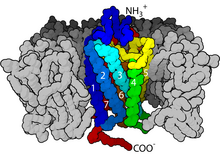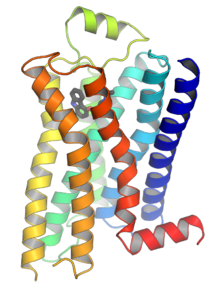หน่วยรับที่จับคู่กับจีโปรตีน
โครงสร้างแบบ α-helix โดยมีโดเมนข้ามเยื่อหุ้มเซลล์ 7 โดเมนของ G protein-coupled receptor หน่วยรับที่จับคู่กับจีโปรตีน (อังกฤษ : G protein-coupled receptors ตัวย่อ GPCRs)
ที่มีชื่ออื่น ๆ อีกว่า seven-(pass)-transmembrane domain receptors, 7TM receptors, heptahelical receptors, serpentine receptor, และ G protein-linked receptors (GPLR),
เป็นกลุ่ม (family) โปรตีนหน่วยรับ (receptor) กลุ่มใหญ่ ที่ตรวจจับโมเลกุล นอกเซลล์ แล้วจุดชนวนวิถีการถ่ายโอนสัญญาณ (signal transduction) ภายในเซลล์ ซึ่งในที่สุดมีผลเป็นการตอบสนองของเซลล์
เป็นหน่วยรับที่จับคู่กับจีโปรตีน (G protein) ที่เรียกว่า seven-transmembrane receptor เพราะมีโครงสร้างที่ข้ามผ่านเยื่อหุ้มเซลล์ ถึง 7 ครั้ง[ 2]
GPCRs จะพบแต่ในยูแคริโอต รวมทั้งยีสต์ , choanoflagellate[ 3] สัตว์
ลิแกนด์ ที่จับและเริ่มการทำงานของหน่วยรับเช่นนี้รวมทั้งสารประกอบ ไวแสง กลิ่น ฟีโรโมน ฮอร์โมน และสารสื่อประสาท โดยมีขนาดต่าง ๆ เริ่มตั้งแต่โมเลกุลเล็ก ๆ จนถึงเพปไทด์ และโปรตีน ขนาดใหญ่
GPCRs มีบทบาทในโรค หลายอย่าง และเป็นเป้าหมายการออกฤทธิ์ของยาปัจจุบันประมาณ 34%[ 4] [ 5] [ 6]
มีวิถีการถ่ายโอนสัญญาณสองอย่างเกี่ยวกับ GPCRs คือ[ 7]
cyclic adenosine monophosphate (cAMP) signal pathway
phosphatidylinositol signal pathway เมื่อลิแกนด์จับกับ GPCR ก็จะทำให้หน่วยรับเปลี่ยนโครงรูป แบบ conformational change ซึ่งทำให้มีฤทธิ์เป็น guanine nucleotide exchange factor (GEF)
แล้วสามารถเริ่มการทำงานของจีโปรตีน โดยแลกเปลี่ยน guanosine diphosphate (GDP) ที่ยึดกับจีโปรตีนกับ guanosine triphosphate (GTP)
หน่วยย่อยแอลฟา (α subunit) ของจีโปรตีนบวกกับ GTP ที่ได้มาใหม่ ก็จะสามารถแยกตัวออกจากหน่วยย่อยบีตาและแกมมาแล้วออกฤทธิ์ต่อโปรตีนส่งสัญญาณภายในเซลล์อื่น ๆ หรือออกฤทธิ์โดยตรงต่อโปรตีนทำหน้าที่ (functional protein) ขึ้นอยู่กับชนิดของหน่วยย่อยแอลฟา (Gαs , Gαi/o , Gαq/11 , Gα12/13 )[ 8] : 1160
รางวัลโนเบลสาขาเคมี ปี 2012 ได้ให้กับงาน (ของ Brian Kobilka และ Robert Lefkowitz) ที่ "สำคัญต่อการเข้าใจว่า หน่วยรับที่จับคู่กับจีโปรตีนทำงานอย่างไร"[ 9] [ต้องการอ้างอิง
โดยปี 2012 ยาที่ขายดีที่สุดในโลก 2 ชนิดจาก 10 ชนิดแรก คือ Fluticasone/salmeterol และ Abilify ออกฤทธิ์ที่หน่วยรับซึ่งจับคู่กับจีโปรตีน[ 10]
การจัดหมวดหมู่ของ GPCRs Class A (Rhodopsin-like), Class B (Secretin-like), Class C (Glutamate Receptor-like), Others (Adhesion (33), Frizzled (11), Taste type-2 (25), unclassified (23)).[ 11] ขนาดหมู่ใหญ่ (superfamily) ของ GPCR ยังไม่ชัดเจน แต่การวิเคราะห์ลำดับจีโนม ในมนุษย์ พยากรณ์ว่า ยีนมนุษย์เกือบ 800 ยีน (หรือประมาณ 4% ของจีโนม ที่เข้ารหัสโปรตีน) เข้ารหัส GPCR[ 11]
ชั้นใหญ่สุดก็คือชั้น A ซึ่งรวมยีน GPCR เกือบ 85%
ในชั้นนี้ เกินครึ่งพยากรณ์ว่า เข้ารหัสหน่วยรับกลิ่น ในขณะที่เหลือจะจับกับลิแกนด์ ซึ่งเป็นสารประกอบ ภายในร่างกายที่รู้จัก หรือจะจัดเป็นหน่วยรับกำพร้า (orphan receptor คือยังไม่รู้ว่ามีลิแกนด์เป็นอะไร)
แม้ชั้นต่าง ๆ จะไม่มีต้นกำเนิดของลำดับร่วมกัน แต่ GPCR ทั้งหมดก็มีโครงสร้างและกลไกถ่ายโอนสัญญาณ ที่เหมือนกัน
ชั้นนี้ยังแบ่งออกเป็นชั้นย่อยอีก 19 กลุ่ม คือ A1-A19[ 12]
งานปี 2006 ได้เสนอระบบการจัดหมวดหมู่ทางเลือกที่เรียกว่า GRAFS (Glutamate, Rhodopsin, Adhesion , Frizzled/Taste2, Secretin)[ 11]
ส่วนตามระบบจัดหมู่เป็น A-F แบบคลาสสิก GPCR สามารถจัดเป็น 6 ชั้น อาศัยต้นกำเนิดลำดับและความคล้ายคลึงกันในการทำงาน[ 13] [ 14] [ 15] [ 16]
Class A (หรือ 1) (Rhodopsin-like)
Class B (หรือ 2) (Secretin receptor family)
Class C (หรือ 3) (Metabotropic glutamate/pheromone)
Class D (หรือ 4) (Fungal mating pheromone receptors)
Class E (หรือ 5) (Cyclic AMP receptors)
Class F (หรือ 6) (Frizzled/Smoothened) งานศึกษาอาศัยลำดับดีเอ็นเอต้น ๆ แสดงว่า จีโนมมนุษย์ เข้ารหัส GPCR 750 ชนิดอย่างคร่าว ๆ[ 17] ฮอร์โมน , growth factors, และลิแกนด์ที่เกิดในร่างกายอื่น ๆ
ประมาณ 150 ชนิดมีหน้าที่ยังไม่ชัดเจน
มีวิธีการต่าง ๆ[ 18] [ 19] [ 20] กรดอะมิโน ของพวกมันอย่างเดียว อาศัยแนวคิด pseudo amino acid composition
GPCR มีบทบาทในกระบวนการทางสรีรภาพ ต่าง ๆ
เช่น
การเห็น - โปรตีนไวแสง opsin จะเปลี่ยนไอโซเมอร์ เมื่อรับแสง เพื่อแปลรังสีแม่เหล็กไฟฟ้า ให้เป็นสัญญาณในเซลล์ เช่น Rhodopsin จะเปลี่ยนจาก 11-cis -retinal เป็น all-trans -retinal เนื่องกับกระบวนการนี้
การรู้รส - GPCR ในเซลล์รับรส จะเริ่มการทำงานของจีโปรตีน คือ gustducin เพื่อตอบสนองต่อรสหวาน ขม และอุมะมิ การได้กลิ่น - หน่วยรับของเยื่อบุผิวรับกลิ่น คือ หน่วยรับกลิ่น จะจับกับโมเลกุลมีกลิ่น ในขณะที่ vomeronasal receptor จะจับกับฟีโรโมน
การควบคุมพฤติกรรม และอารมณ์ - หน่วยรับ ในสมอง สัตว์เลี้ยงลูกด้วยนมสามารถจับกับสารสื่อประสาท ต่าง ๆ รวมทั้งเซโรโทนิน โดพามีน GABA (Gamma-aminobutyric acid) และกลูตาเมต
การควบคุมการทำงานของระบบภูมิคุ้มกัน และกระบวนการอักเสบ - หน่วยรับ Chemokine receptor จะจับกับลิแกนด์ที่อำนวยการสื่อสารระหว่างเซลล์ต่าง ๆ ของระบบภูมิคุ้มกัน หน่วยรับ เช่น หน่วยรับฮิสตามีน จะจับกับตัวอำนวยการอักเสบ (inflammatory mediator) และเริ่มการทำงานของเซลล์เป้าหมายชนิดต่าง ๆ ในการตอบสนองเป็นการอักเสบ GPCR ยังมีบทบาทในการปรับระบบภูมิคุ้มกัน และมีบทบาทโดยตรงในการยับยั้งการตอบสนองจากเซลล์ที (T cell) ที่ชักนำโดย TLR[ 21]
การสื่อประสาทในระบบประสาทอิสระ ทั้งระบบประสาทซิมพาเทติก และระบบประสาทพาราซิมพาเทติก จะควบคุมโดยวิถีการส่งสัญญาณผ่าน GPCR ซึ่งมีบทบาทควบคุมระบบอัตโนมัติต่าง ๆ ในร่างกาย เช่น ความดันโลหิต อัตราการเต้นหัวใจ และการย่อยอาหาร
การรับรู้ความหนาแน่นของเซลล์
การปรับภาวะธำรงดุล (เช่นความสมดุลของน้ำ).[ 22]
บทบาทในการเติบโตและแพร่กระจาย ของเนื้องอก บางอย่าง[ 23]
↑ Cherezov, V; Rosenbaum, DM; Hanson, MA; Rasmussen, SG; Thian, FS; Kobilka, TS; Choi, HJ; Kuhn, P; Weis, WI; Kobilka, BK; Stevens, RC (November 2007). "High-resolution crystal structure of an engineered human beta2-adrenergic G protein-coupled receptor" . Science . 318 (5854): 1258–65. doi :10.1126/science.1150577 . PMC 2583103 PMID 17962520 . {{cite journal }}: CS1 maint: uses authors parameter (ลิงก์ )↑ Trzaskowski, B; Latek, D; Yuan, S; Ghoshdastider, U; Debinski, A; Filipek, S (2012). "Action of molecular switches in GPCRs—theoretical and experimental studies" . Current Medicinal Chemistry . 19 (8): 1090–109. doi :10.2174/092986712799320556 . PMC 3343417 PMID 22300046 . {{cite journal }}: CS1 maint: uses authors parameter (ลิงก์ )↑ King, N; Hittinger, CT; Carroll, SB (July 2003). "Evolution of key cell signaling and adhesion protein families predates animal origins". Science . 301 (5631): 361–3. doi :10.1126/science.1083853 . PMID 12869759 . {{cite journal }}: CS1 maint: uses authors parameter (ลิงก์ )↑
Filmore, D (2004). "It's a GPCR world" . Modern Drug Discovery . American Chemical Society. 2004 (November): 24–28. {{cite journal }}: CS1 maint: uses authors parameter (ลิงก์ )
↑
Overington, JP; Al-Lazikani, B; Hopkins, AL (December 2006). "How many drug targets are there?". Nature Reviews. Drug Discovery . 5 (12): 993–6. doi :10.1038/nrd2199 . PMID 17139284 . {{cite journal }}: CS1 maint: uses authors parameter (ลิงก์ )
↑
Hauser, Alexander S.; Attwood, Misty M.; Rask-Andersen, Mathias; Schiöth, Helgi B.; Gloriam, David E. (October 2017). "Trends in GPCR drug discovery: new agents, targets and indications" . Nature Reviews Drug Discovery . doi :10.1038/nrd.2017.178 . PMID 29075003 . สืบค้นเมื่อ 7 November 2017 .
↑ Gilman, AG (1987). "G proteins: transducers of receptor-generated signals". Annual Review of Biochemistry . 56 (1): 615–49. doi :10.1146/annurev.bi.56.070187.003151 . PMID 3113327 . {{cite journal }}: CS1 maint: uses authors parameter (ลิงก์ )↑ Wettschureck, N; Offermanns, S (October 2005). "Mammalian G proteins and their cell type specific functions". Physiological Reviews . 85 (4): 1159–204. doi :10.1152/physrev.00003.2005 . PMID 16183910 . {{cite journal }}: CS1 maint: uses authors parameter (ลิงก์ )↑ Royal Swedish Academy of Sciences (10 October 2012). "The Nobel Prize in Chemistry 2012 Robert J. Lefkowitz, Brian K. Kobilka" . สืบค้นเมื่อ 10 October 2012 . ↑ "The Top Prescription Drugs of 2012 Globally: Biologics Dominate, But Small Molecule CNS Drugs Hold on to Top Spots" (PDF ) . ACS Chemical Neuroscience . สืบค้นเมื่อ 3 February 2016 .↑ 11.0 11.1 11.2 Bjarnadóttir, TK; Gloriam, DE; Hellstrand, SH; Kristiansson, H; Fredriksson, R; Schiöth, HB (September 2006). "Comprehensive repertoire and phylogenetic analysis of the G protein-coupled receptors in human and mouse". Genomics . 88 (3): 263–73. doi :10.1016/j.ygeno.2006.04.001 . PMID 16753280 . {{cite journal }}: CS1 maint: uses authors parameter (ลิงก์ )↑ Joost, P; Methner, A (October 2002). "Phylogenetic analysis of 277 human G-protein-coupled receptors as a tool for the prediction of orphan receptor ligands" . Genome Biology . 3 (11): RESEARCH0063. doi :10.1186/gb-2002-3-11-research0063 . PMC 133447 PMID 12429062 . {{cite journal }}: CS1 maint: uses authors parameter (ลิงก์ )↑
Attwood, TK; Findlay, JB (February 1994). "Fingerprinting G-protein-coupled receptors" . Protein Engineering . 7 (2): 195–203. doi :10.1093/protein/7.2.195 . PMID 8170923 . {{cite journal }}: CS1 maint: uses authors parameter (ลิงก์ )
↑
Kolakowski, LF (1994). "GCRDb: a G-protein-coupled receptor database". Receptors & Channels . 2 (1): 1–7. PMID 8081729 . {{cite journal }}: CS1 maint: uses authors parameter (ลิงก์ )
↑
Foord, SM; Bonner, TI; Neubig, RR; Rosser, EM; Pin, JP; Davenport, AP; Spedding, M; Harmar, AJ (June 2005). "International Union of Pharmacology. XLVI. G protein-coupled receptor list". Pharmacological Reviews . 57 (2): 279–88. doi :10.1124/pr.57.2.5 . PMID 15914470 . {{cite journal }}: CS1 maint: uses authors parameter (ลิงก์ )
↑
"gpcr" . InterPro.
↑ Vassilatis, DK; Hohmann, JG; Zeng, H; Li, F; Ranchalis, JE; Mortrud, MT; Brown, A; Rodriguez, SS; Weller, JR; Wright, AC; Bergmann, JE; Gaitanaris, GA (April 2003). "The G protein-coupled receptor repertoires of human and mouse" . Proceedings of the National Academy of Sciences of the United States of America . 100 (8): 4903–8. doi :10.1073/pnas.0230374100 . PMC 153653 PMID 12679517 . {{cite journal }}: CS1 maint: uses authors parameter (ลิงก์ )↑
Xiao, X; Wang, P; Chou, KC (July 2009). "GPCR-CA: A cellular automaton image approach for predicting G-protein-coupled receptor functional classes". Journal of Computational Chemistry . 30 (9): 1414–23. doi :10.1002/jcc.21163 . PMID 19037861 . {{cite journal }}: CS1 maint: uses authors parameter (ลิงก์ )
↑
Qiu, JD; Huang, JH; Liang, RP; Lu, XQ (July 2009). "Prediction of G-protein-coupled receptor classes based on the concept of Chou's pseudo amino acid composition: an approach from discrete wavelet transform". Analytical Biochemistry . 390 (1): 68–73. doi :10.1016/j.ab.2009.04.009 . PMID 19364489 . {{cite journal }}: CS1 maint: uses authors parameter (ลิงก์ )
↑
Gu, Q; Ding, YS; Zhang, TL (May 2010). "Prediction of G-protein-coupled receptor classes in low homology using Chou's pseudo amino acid composition with approximate entropy and hydrophobicity patterns". Protein and Peptide Letters . 17 (5): 559–67. doi :10.2174/092986610791112693 . PMID 19594431 . {{cite journal }}: CS1 maint: uses authors parameter (ลิงก์ )
↑ Sharma, N; Akhade, AS; Qadri, A (April 2013). "Sphingosine-1-phosphate suppresses TLR-induced CXCL8 secretion from human T cells". Journal of Leukocyte Biology . 93 (4): 521–8. doi :10.1189/jlb.0712328 . PMID 23345392 . {{cite journal }}: CS1 maint: uses authors parameter (ลิงก์ )↑ Hazell, GG; Hindmarch, CC; Pope, GR; Roper, JA; Lightman, SL; Murphy, D; O'Carroll, AM; Lolait, SJ (January 2012). "G protein-coupled receptors in the hypothalamic paraventricular and supraoptic nuclei—serpentine gateways to neuroendocrine homeostasis" . Frontiers in Neuroendocrinology . 33 (1): 45–66. doi :10.1016/j.yfrne.2011.07.002 . PMC 3336209 PMID 21802439 . {{cite journal }}: CS1 maint: uses authors parameter (ลิงก์ )↑ Dorsam, RT; Gutkind, JS (February 2007). "G-protein-coupled receptors and cancer". Nature Reviews. Cancer . 7 (2): 79–94. doi :10.1038/nrc2069 . PMID 17251915 . {{cite journal }}: CS1 maint: uses authors parameter (ลิงก์ )
G-protein-coupled receptors ในหอสมุดแพทยศาสตร์แห่งชาติอเมริกัน สำหรับหัวข้อเนื้อหาทางการแพทย์ (MeSH)Vassilatis, DK; Hohmann, JG; Zeng, H; Li, F; Ranchalis, JE; Mortrud, MT; Brown, A; Rodriguez, SS; Weller, JR; Wright, AC; Bergmann, JE; Gaitanaris, GA (2003). "The G protein-coupled receptor repertoires of human and mouse" . Proc. Natl. Acad. Sci. U.S.A . 100 (8): 4903–8. doi :10.1073/pnas.0230374100 . PMC 153653 PMID 12679517 . {{cite journal }}: CS1 maint: uses authors parameter (ลิงก์ )"GPCR Reference Library" . สืบค้นเมื่อ 11 August 2008 . Reference for molecular and mathematical models for the initial receptor response "The Nobel Prize in Chemistry 2012" (PDF) . สืบค้นเมื่อ 10 October 2012 .GPCR Cell Line "GPCR Database" . IUPHAR Database . International Union of Basic and Clinical Pharmacology. คลังข้อมูลเก่าเก็บจากแหล่งเดิม เมื่อ 15 September 2008. สืบค้นเมื่อ 11 August 2008 ."GPCRdb" . Data, diagrams and web tools for G protein-coupled receptors (GPCRs). Munk, C; Isberg, V; Mordalski, S; Harpsøe, K; Rataj, K; Hauser, AS; Kolb, P; Bojarski, AJ; Vriend, G; Gloriam, DE (2016). "GPCRdb: the G Protein-Coupled Receptor Database - an Introduction" . British Journal of Pharmacology . 173 (14): 2195–207. doi :10.1111/bph.13509 . PMC 4919580 PMID 27155948 . {{cite journal }}: CS1 maint: uses authors parameter (ลิงก์ )"G Protein-Coupled Receptors on the NET" . คลังข้อมูลเก่าเก็บจากแหล่งเดิม เมื่อ 2011-07-23. สืบค้นเมื่อ 10 November 2010 . a classification of GPCRs "PSI GPCR Network Center" . คลังข้อมูลเก่าเก็บจากแหล่งเดิม เมื่อ 25 July 2013. สืบค้นเมื่อ 11 July 2013 . a Protein Structure Initiative:Biology Network Center aimed at determining the 3D structures of representative GPCR family proteins


